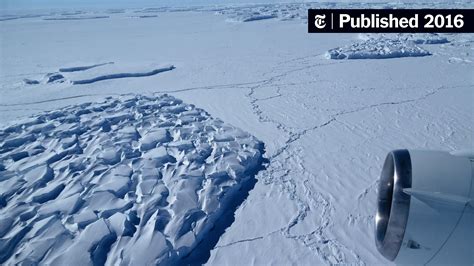
Scientists are reporting an unexpected and significant shift in the stability of a portion of the Antarctic ice sheet, specifically in the region of the Weddell Sea. Satellite data reveals a slowing in the acceleration of ice loss, a phenomenon researchers are calling a “historic turnaround” that defies previous projections of rapid and irreversible decline. While cautioning against premature celebration, the findings offer a glimmer of hope and highlight the complex and still poorly understood dynamics of polar ice sheets in a warming world.
The surprising discovery, based on analysis of satellite measurements spanning several decades, focuses on the eastern side of the Weddell Sea Embayment. According to the study, the rate at which ice was being discharged into the ocean from this area has slowed considerably. This contrasts sharply with other parts of Antarctica, particularly West Antarctica, where ice loss continues to accelerate at an alarming pace, contributing significantly to global sea level rise.
“We’ve detected what we’re calling a turnaround, a historic turnaround, in this one sector of Antarctica,” explained Dr. Bernd Scheuchl, a researcher at the University of California, Irvine, and a lead author of the study. “That’s the good news. The bad news is that the overall trend in Antarctica is still one of massive ice loss.”
The observed slowing is attributed, in part, to changes in ocean currents and wind patterns that have brought cooler waters to the region. These cooler waters have reduced the rate of melting at the base of the ice shelves, which are floating extensions of the ice sheet that act as buttresses, slowing the flow of ice into the ocean.
However, scientists emphasize that this regional stabilization does not negate the broader threat posed by climate change to the Antarctic ice sheet as a whole. The West Antarctic Ice Sheet, particularly the Thwaites and Pine Island glaciers, remains highly vulnerable to collapse, and their continued melting could lead to catastrophic sea level rise. The findings underscore the need for continued monitoring and research to better understand the complex interactions between the ocean, atmosphere, and ice in Antarctica.
A Closer Look at the Weddell Sea Turnaround
The Weddell Sea, a vast expanse of ocean bordering the Antarctic continent, plays a crucial role in regulating global climate. Its frigid waters are a major site of deep water formation, driving ocean currents that distribute heat around the planet. The sea is also home to a number of large ice shelves, including the Filchner-Ronne Ice Shelf, which is the second largest in Antarctica.
The recent study focused on the eastern portion of the Weddell Sea Embayment, an area that has historically been considered relatively stable compared to West Antarctica. However, even in this region, there had been concerns about the potential for increased ice loss due to warming ocean temperatures.
The satellite data revealed that, contrary to expectations, the rate of ice discharge from this area has slowed down significantly in recent years. This slowing is particularly evident in the grounding line, the point where the ice sheet begins to float and become an ice shelf. The grounding line is a critical boundary, as its retreat can lead to accelerated ice loss.
“We were surprised to see this turnaround,” said Dr. Isabella Velicogna, a professor of Earth System Science at the University of California, Irvine, and another lead author of the study. “It suggests that the dynamics of the Antarctic ice sheet are more complex than we previously thought.”
The researchers attribute the slowing in ice loss to a combination of factors, including changes in ocean currents and wind patterns. Specifically, they believe that cooler waters have been brought to the region by a shift in the Antarctic Circumpolar Current, a powerful current that encircles the continent. These cooler waters have reduced the rate of melting at the base of the ice shelves, helping to stabilize the grounding line.
The Role of Ice Shelves
Ice shelves play a critical role in maintaining the stability of the Antarctic ice sheet. They act as buttresses, slowing the flow of ice into the ocean. When ice shelves melt or collapse, the glaciers behind them can accelerate, leading to a rapid increase in sea level rise.
The Filchner-Ronne Ice Shelf, which is located in the Weddell Sea, is one of the largest ice shelves in Antarctica. It is particularly important because it helps to stabilize a large portion of the East Antarctic Ice Sheet, which is the largest ice sheet on Earth.
The recent study suggests that the Filchner-Ronne Ice Shelf is currently in a relatively stable state, thanks to the influx of cooler waters. However, scientists caution that this stability could be temporary. Changes in ocean currents and wind patterns could reverse the trend, leading to increased melting and a potential collapse of the ice shelf.
West Antarctica: A Contrasting Picture
While the eastern Weddell Sea shows signs of stabilization, the situation in West Antarctica remains dire. The West Antarctic Ice Sheet is highly vulnerable to climate change, and its continued melting is a major concern for sea level rise.
The Thwaites and Pine Island glaciers, which are located in West Antarctica, are two of the fastest-melting glaciers in the world. They are responsible for a significant portion of the ice loss from the Antarctic ice sheet, and their collapse could lead to a rapid and substantial increase in sea level.
Scientists believe that the Thwaites and Pine Island glaciers are particularly vulnerable because they are grounded on bedrock that slopes downwards towards the interior of the continent. This means that as the glaciers retreat, they expose more of their base to warm ocean waters, leading to further melting.
“The West Antarctic Ice Sheet is a ticking time bomb,” said Dr. Eric Rignot, a professor of Earth System Science at the University of California, Irvine, and a leading expert on Antarctic ice loss. “Its collapse is inevitable, and it will have a devastating impact on coastal communities around the world.”
Implications for Sea Level Rise Projections
The surprising findings from the Weddell Sea have implications for sea level rise projections. While the slowing in ice loss in this region is encouraging, it does not negate the overall threat posed by climate change to the Antarctic ice sheet.
The Intergovernmental Panel on Climate Change (IPCC) has projected that global sea levels could rise by as much as one meter by the end of the century. This rise would be enough to inundate many coastal cities and displace millions of people.
The IPCC’s projections are based on a range of scenarios, including one in which the Antarctic ice sheet collapses rapidly. The recent findings from the Weddell Sea suggest that this scenario may be less likely than previously thought, but scientists caution that it is still a possibility.
“We need to be careful about extrapolating these findings to the entire Antarctic ice sheet,” said Dr. Velicogna. “The West Antarctic Ice Sheet is still a major concern, and its continued melting could lead to significant sea level rise.”
The Need for Continued Monitoring and Research
The recent study underscores the need for continued monitoring and research to better understand the complex dynamics of the Antarctic ice sheet. Satellites provide a valuable tool for monitoring changes in ice thickness and flow velocity, but they cannot tell us everything about what is happening beneath the ice.
Scientists also need to conduct more research on the interaction between the ocean, atmosphere, and ice in Antarctica. This research will help them to better understand the factors that are driving ice loss and to develop more accurate projections of future sea level rise.
“The Antarctic ice sheet is a complex system, and we still have a lot to learn about it,” said Dr. Scheuchl. “We need to continue to monitor the ice sheet closely and to conduct more research to better understand its dynamics.”
Global Implications
The stability of the Antarctic ice sheet has profound implications for the entire planet. The ice sheet contains enough water to raise global sea levels by nearly 60 meters, and its melting could have catastrophic consequences for coastal communities around the world.
The recent findings from the Weddell Sea offer a glimmer of hope, but they also highlight the need for urgent action to reduce greenhouse gas emissions. Climate change is the primary driver of ice loss in Antarctica, and unless we take steps to curb emissions, the ice sheet will continue to melt, leading to rising sea levels and increased coastal flooding.
The future of the Antarctic ice sheet depends on the choices we make today. By reducing greenhouse gas emissions and investing in research, we can help to protect this critical part of our planet and safeguard coastal communities for future generations.
Detailed Analysis and Expanded Context
The discovery of a slowing trend in ice loss within a specific sector of the Antarctic ice sheet, particularly the eastern Weddell Sea Embayment, presents a nuanced and complex picture that requires careful analysis. This “historic turnaround,” as described by researchers, does not signal a reversal of overall ice loss across Antarctica, but rather highlights the regional variability and the influence of dynamic oceanographic and atmospheric processes on ice sheet stability.
Oceanic and Atmospheric Drivers
The observed stabilization in the eastern Weddell Sea is primarily attributed to changes in ocean currents and wind patterns. Specifically, an increase in the influx of cooler, less saline water into the region is believed to have reduced the rate of basal melting of ice shelves. Basal melting refers to the melting of ice from beneath, caused by contact with relatively warmer ocean water. Ice shelves, as previously mentioned, act as crucial buttresses, restraining the flow of grounded ice into the ocean. When these ice shelves are weakened by basal melting, the glaciers that feed into them can accelerate, leading to increased ice discharge and sea level rise.
The mechanism driving the influx of cooler water is thought to be related to shifts in the Antarctic Circumpolar Current (ACC) and changes in regional wind patterns. The ACC is the world’s largest ocean current, encircling Antarctica and playing a key role in distributing heat around the globe. Variations in the ACC’s strength and position can influence the temperature and salinity of waters that reach the Antarctic coast. Similarly, changes in wind patterns can affect the upwelling of deep ocean waters, which can be relatively warm, and the advection of surface waters, which are typically colder.
The specific interplay of these oceanic and atmospheric factors in the eastern Weddell Sea is still under investigation. However, the available evidence suggests that a combination of increased cooler water influx and reduced warm water upwelling has contributed to the observed slowing in ice loss.
Implications for Ice Sheet Modeling
The findings from the Weddell Sea have significant implications for ice sheet modeling. Ice sheet models are computer simulations that are used to project the future behavior of ice sheets under different climate scenarios. These models are essential tools for understanding the potential impacts of climate change on sea level rise.
The traditional ice sheet models often simplify the complex interactions between the ocean, atmosphere, and ice. The recent discovery highlights the importance of incorporating more detailed representations of these interactions into the models. The models need to account for regional variations in ocean temperature, salinity, and circulation, as well as the effects of wind patterns and atmospheric variability.
By improving the representation of these processes, ice sheet models can provide more accurate projections of future sea level rise. This information is crucial for policymakers and coastal communities who are planning for the impacts of climate change.
East Antarctic Ice Sheet Stability
The East Antarctic Ice Sheet (EAIS), which comprises the majority of the Antarctic ice mass, has long been considered relatively stable compared to the West Antarctic Ice Sheet (WAIS). However, recent studies have revealed that the EAIS is not immune to the effects of climate change.
While the eastern Weddell Sea shows signs of stabilization, other parts of the EAIS are experiencing increased ice loss. For example, the Totten Glacier, which is located in East Antarctica, is one of the largest and fastest-thinning glaciers in the region. Its melting is contributing significantly to sea level rise.
The stability of the EAIS is influenced by a complex interplay of factors, including ocean temperature, snowfall rates, and the topography of the underlying bedrock. Understanding these factors is crucial for projecting the future behavior of the EAIS and its contribution to sea level rise.
The Broader Context of Antarctic Ice Loss
It is crucial to emphasize that the localized stabilization in the eastern Weddell Sea does not negate the overall trend of ice loss in Antarctica. The WAIS continues to be highly vulnerable to climate change, and its continued melting poses a significant threat to coastal communities around the world.
The Thwaites and Pine Island glaciers, which are located in West Antarctica, are two of the most closely watched glaciers in the world. They are responsible for a substantial portion of the ice loss from the Antarctic ice sheet, and their collapse could lead to a rapid and substantial increase in sea level.
Scientists are particularly concerned about the potential for a marine ice sheet instability (MISI) to develop in West Antarctica. MISI is a process in which the retreat of a glacier leads to a further reduction in the buttressing effect of ice shelves, causing the glacier to accelerate and retreat even faster. This process can lead to a runaway collapse of the ice sheet.
The findings from the Weddell Sea highlight the need for a more nuanced understanding of the dynamics of the Antarctic ice sheet. While some regions may be stabilizing, others are continuing to experience rapid ice loss. It is crucial to continue monitoring the ice sheet closely and to conduct more research to better understand its complex behavior.
Policy Implications and Mitigation Strategies
The implications of these findings extend beyond scientific understanding and directly inform policy decisions related to climate change mitigation and adaptation. While the slight respite observed in the Weddell Sea provides a degree of optimism, it reinforces the importance of targeted climate action and highlights the need for adaptable strategies.
Firstly, the results underscore the necessity of adhering to and strengthening international agreements, such as the Paris Agreement, aimed at reducing greenhouse gas emissions. These agreements provide a framework for collective action to mitigate climate change and prevent further ice loss in Antarctica.
Secondly, the findings emphasize the importance of investing in climate change adaptation measures. Coastal communities need to prepare for the impacts of sea level rise, including increased flooding, erosion, and saltwater intrusion. Adaptation measures may include building seawalls, restoring coastal wetlands, and relocating infrastructure.
Thirdly, the research highlights the need for continued investment in scientific research on the Antarctic ice sheet. Better understanding of the complex dynamics of the ice sheet is crucial for developing more accurate projections of future sea level rise and for informing policy decisions.
Future Research Directions
The “historic turnaround” detected in the eastern Weddell Sea presents a valuable opportunity to advance our understanding of the Antarctic ice sheet and its response to climate change. Future research should focus on the following areas:
- Detailed Oceanographic Studies: More detailed oceanographic studies are needed to understand the mechanisms driving the changes in ocean currents and wind patterns that are affecting the Weddell Sea. These studies should include measurements of ocean temperature, salinity, and circulation, as well as observations of wind patterns and atmospheric variability.
- Ice Sheet Modeling Improvements: Ice sheet models need to be improved to better represent the complex interactions between the ocean, atmosphere, and ice. This includes incorporating more detailed representations of ocean currents, wind patterns, and basal melting processes.
- Monitoring of Ice Shelf Stability: Continued monitoring of ice shelf stability is crucial for detecting changes in ice thickness and flow velocity. This monitoring should include satellite observations, as well as ground-based measurements.
- Investigation of East Antarctic Ice Sheet Dynamics: More research is needed to understand the dynamics of the East Antarctic Ice Sheet and its response to climate change. This includes investigating the factors that are controlling the stability of the Totten Glacier and other vulnerable glaciers in East Antarctica.
- Assessment of Marine Ice Sheet Instability Potential: Further research is needed to assess the potential for a marine ice sheet instability to develop in West Antarctica. This includes investigating the factors that are controlling the retreat of the Thwaites and Pine Island glaciers and developing models to simulate the dynamics of marine ice sheets.
Conclusion
The discovery of a slowing trend in ice loss in the eastern Weddell Sea is a significant finding that highlights the complex dynamics of the Antarctic ice sheet. While this localized stabilization provides a degree of optimism, it does not negate the overall trend of ice loss in Antarctica. The West Antarctic Ice Sheet remains highly vulnerable to climate change, and its continued melting poses a significant threat to coastal communities around the world.
Continued monitoring and research are crucial for better understanding the complex dynamics of the Antarctic ice sheet and for developing more accurate projections of future sea level rise. By reducing greenhouse gas emissions and investing in climate change adaptation measures, we can help to protect this critical part of our planet and safeguard coastal communities for future generations. The future of the Antarctic ice sheet, and indeed the world’s coastlines, depends on the actions we take today.
Frequently Asked Questions (FAQ)
1. What exactly is the “historic turnaround” being reported in Antarctica?
The “historic turnaround” refers to a slowing in the acceleration of ice loss specifically observed in the eastern portion of the Weddell Sea Embayment in Antarctica. Satellite data indicates that the rate at which ice is being discharged into the ocean from this region has decreased, contrasting with the overall trend of accelerating ice loss across the continent, particularly in West Antarctica. This doesn’t mean ice loss has stopped, but the rate has reduced.
2. Does this mean Antarctica is no longer losing ice and contributing to sea level rise?
No. While the slowing in ice loss in the eastern Weddell Sea is a positive sign, it doesn’t negate the overall trend of ice loss in Antarctica. The West Antarctic Ice Sheet, particularly the Thwaites and Pine Island glaciers, continues to experience significant melting and remains a major contributor to global sea level rise. The eastern Weddell Sea’s relative stabilization is a regional anomaly, not a continent-wide reversal.
3. What are the reasons behind this unexpected slowing in ice loss in the Weddell Sea?
Scientists attribute the slowing to a combination of factors, primarily changes in ocean currents and wind patterns. These changes have led to an influx of cooler waters into the region, reducing the rate of melting at the base of the ice shelves. Cooler waters have lessened the basal melting of the ice shelves.
4. How will this discovery affect projections of future sea level rise?
The discovery introduces greater complexity into sea level rise projections. While the slowing in ice loss in the eastern Weddell Sea is encouraging, it doesn’t fundamentally alter the overall projections, which still indicate a significant rise in sea levels due to Antarctic ice loss. The findings highlight the need for more refined models that account for regional variations and dynamic oceanographic processes. It could lead to minor adjustments in the upper ranges of sea-level rise projections, but not a significant downward revision.
5. What is the significance of the ice shelves mentioned in the article?
Ice shelves are floating extensions of the ice sheet that play a crucial role in maintaining its stability. They act as buttresses, slowing the flow of ice into the ocean. When ice shelves melt or collapse, the glaciers behind them can accelerate, leading to a rapid increase in sea level rise. The Filchner-Ronne Ice Shelf, located in the Weddell Sea, is one of the largest in Antarctica and is particularly important for stabilizing a large portion of the East Antarctic Ice Sheet. Protecting these ice shelves is vital to slowing down ice discharge from the continent.









